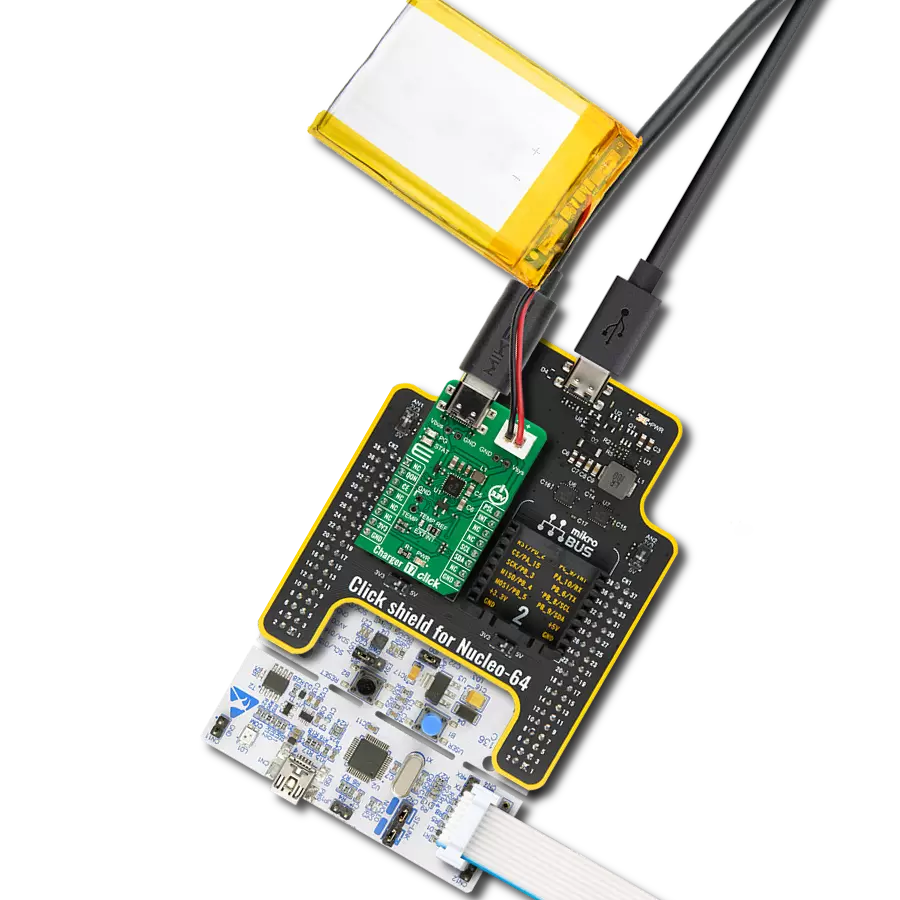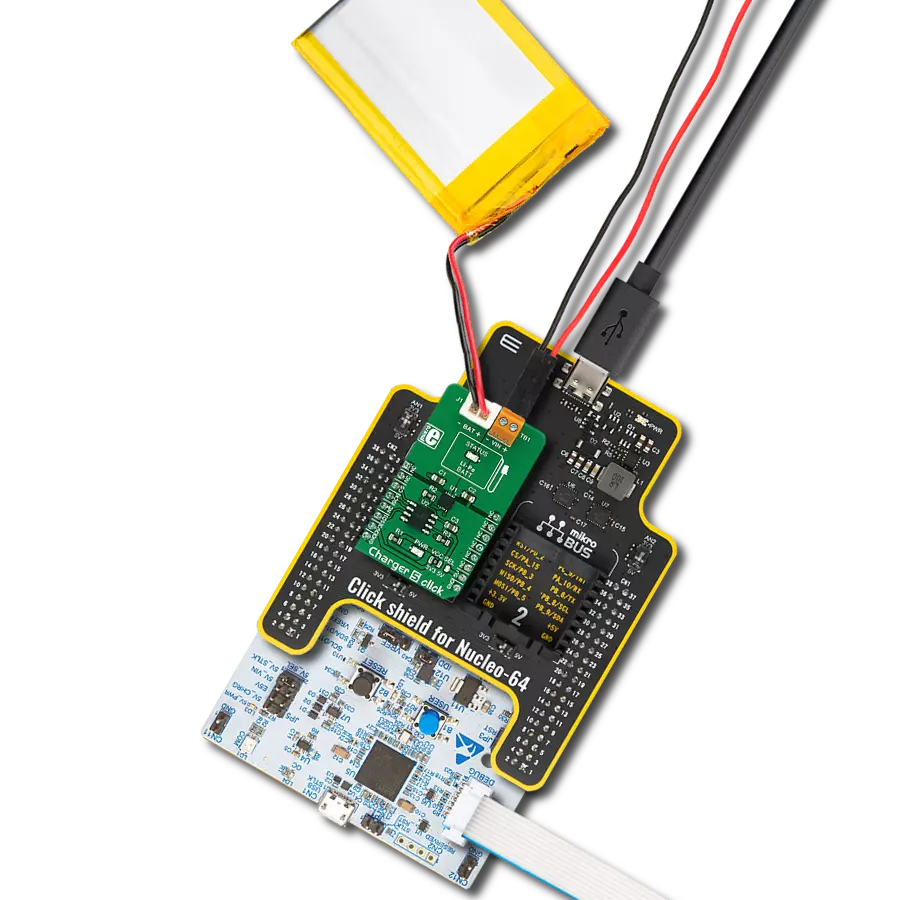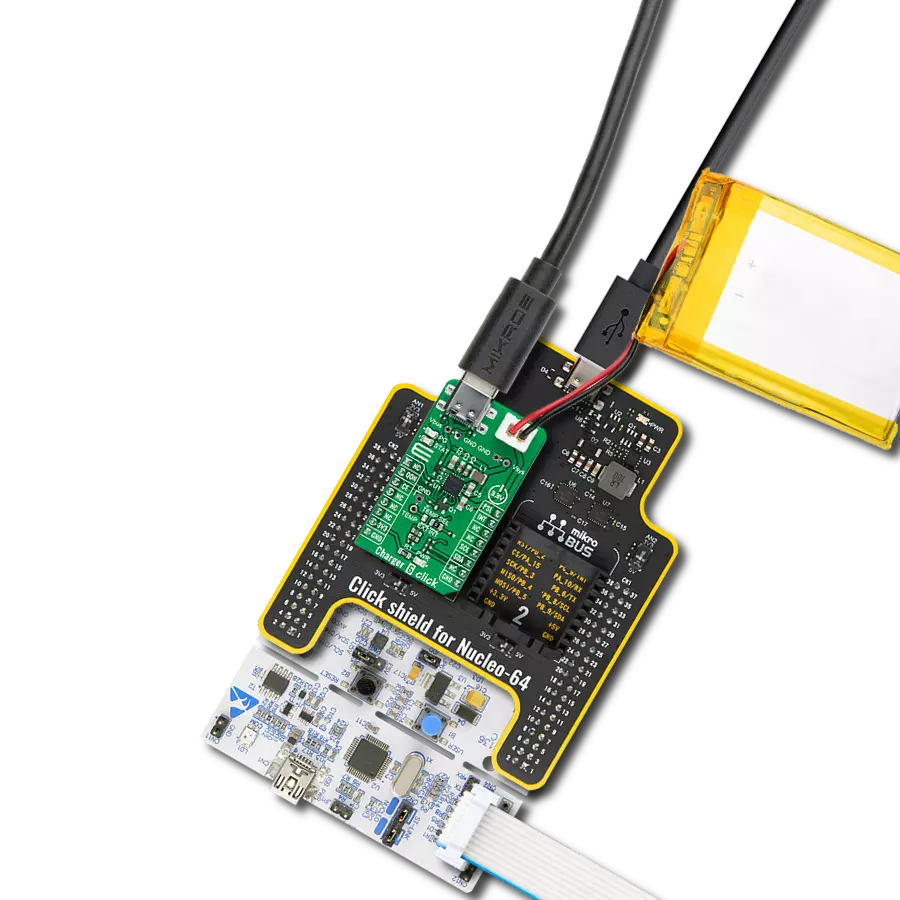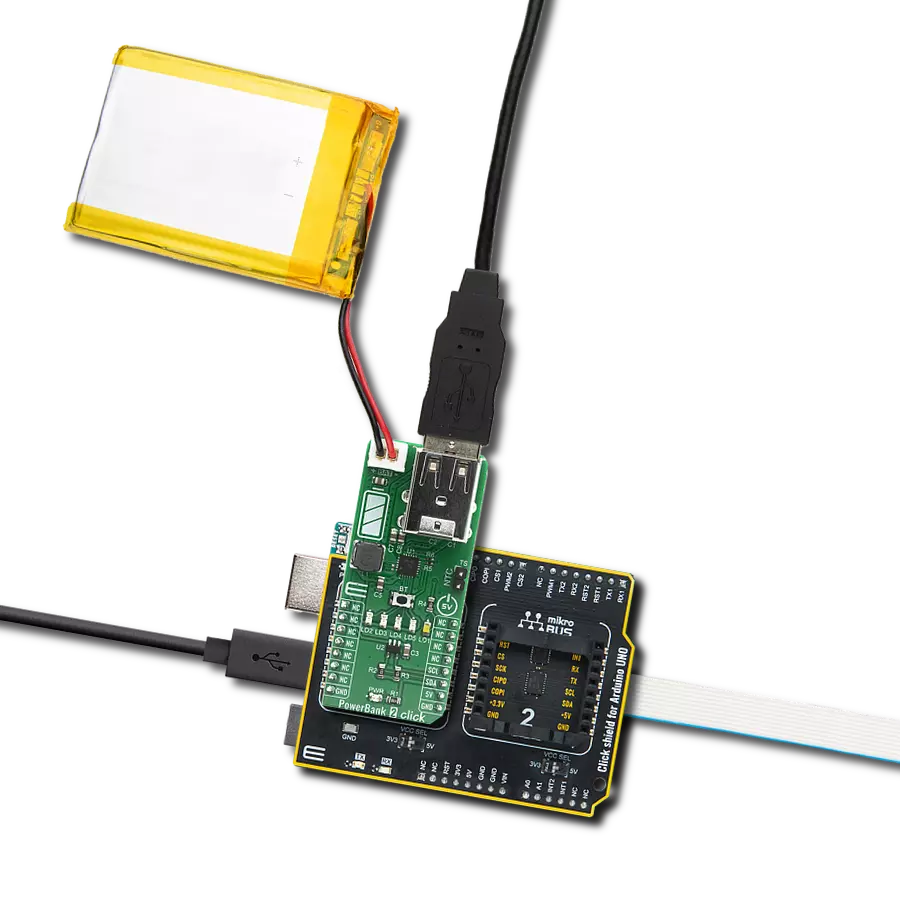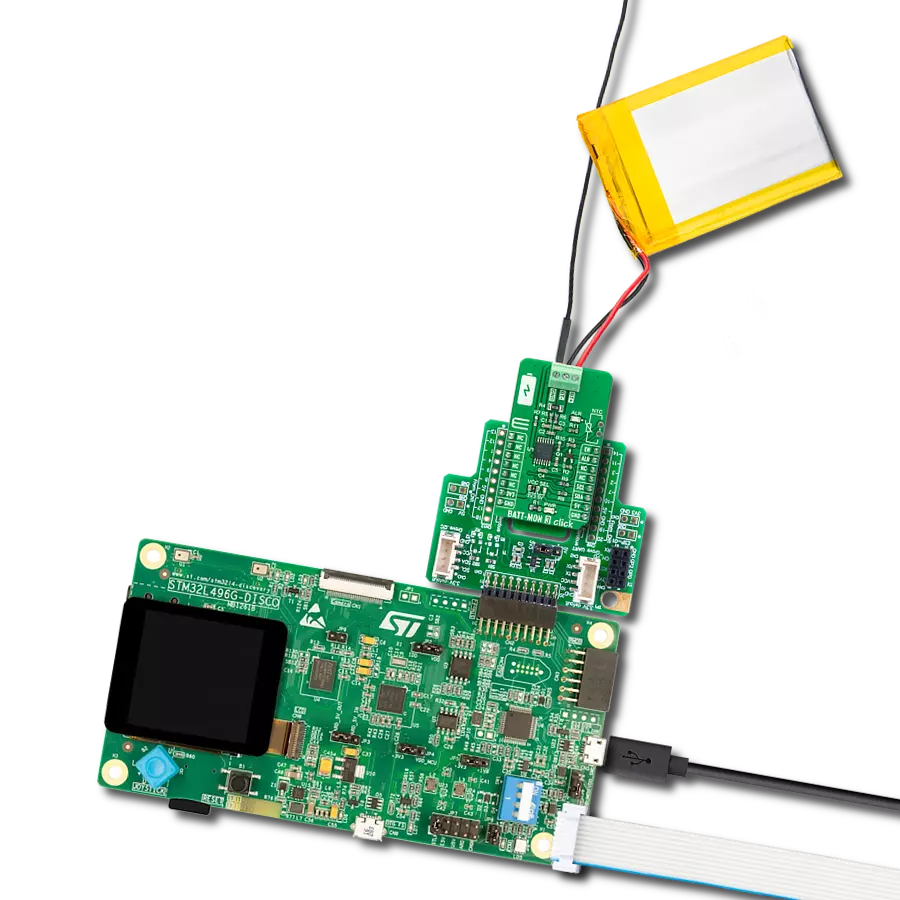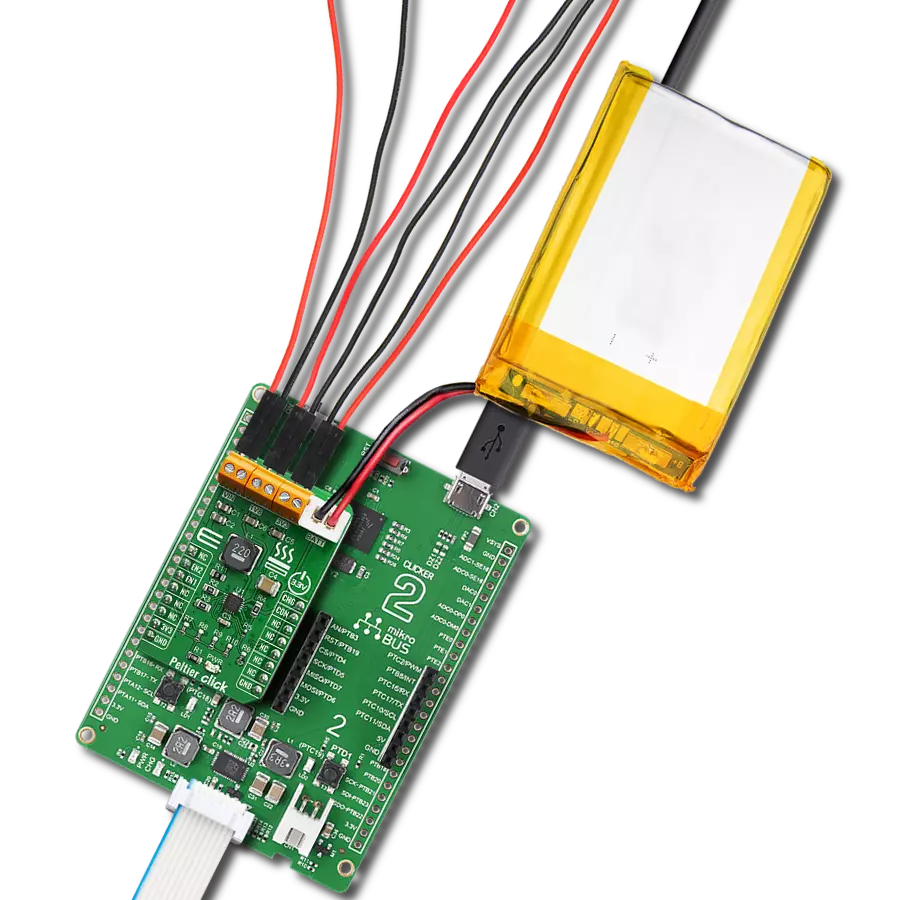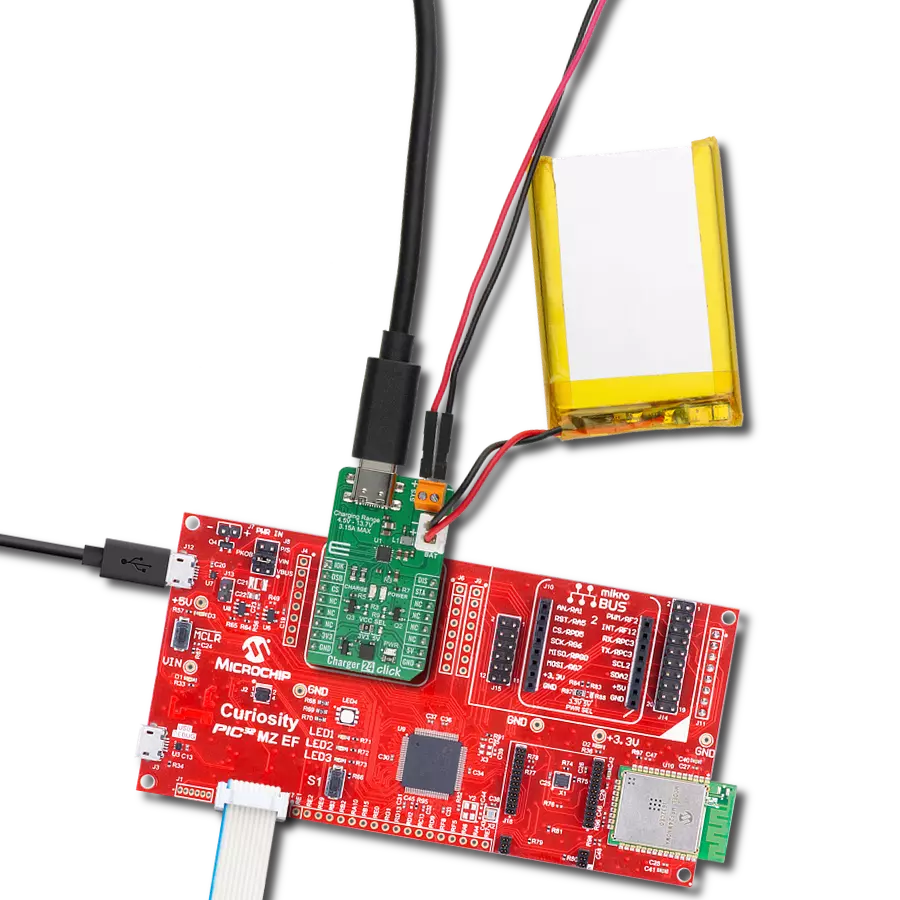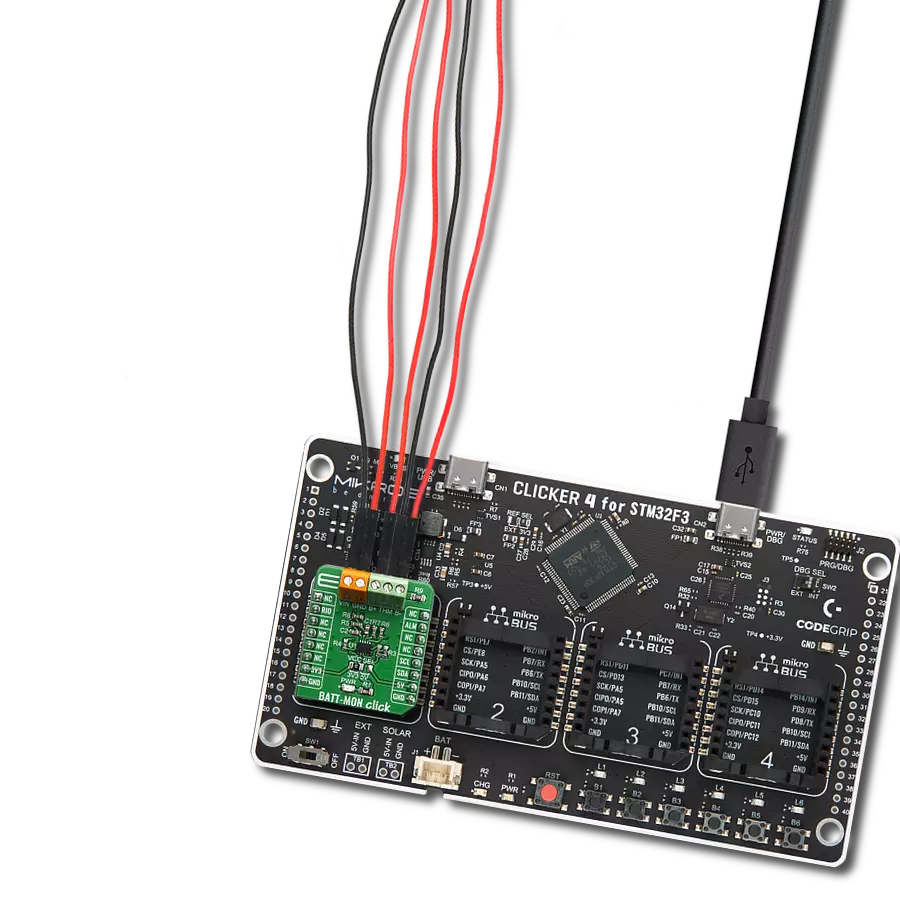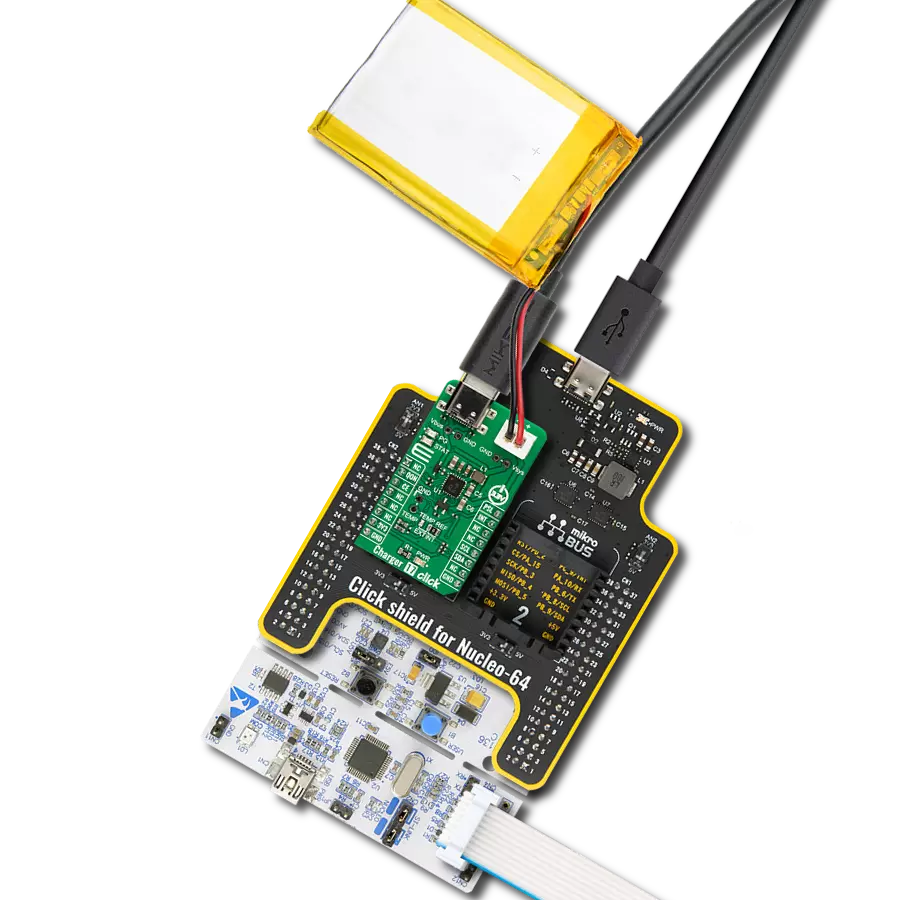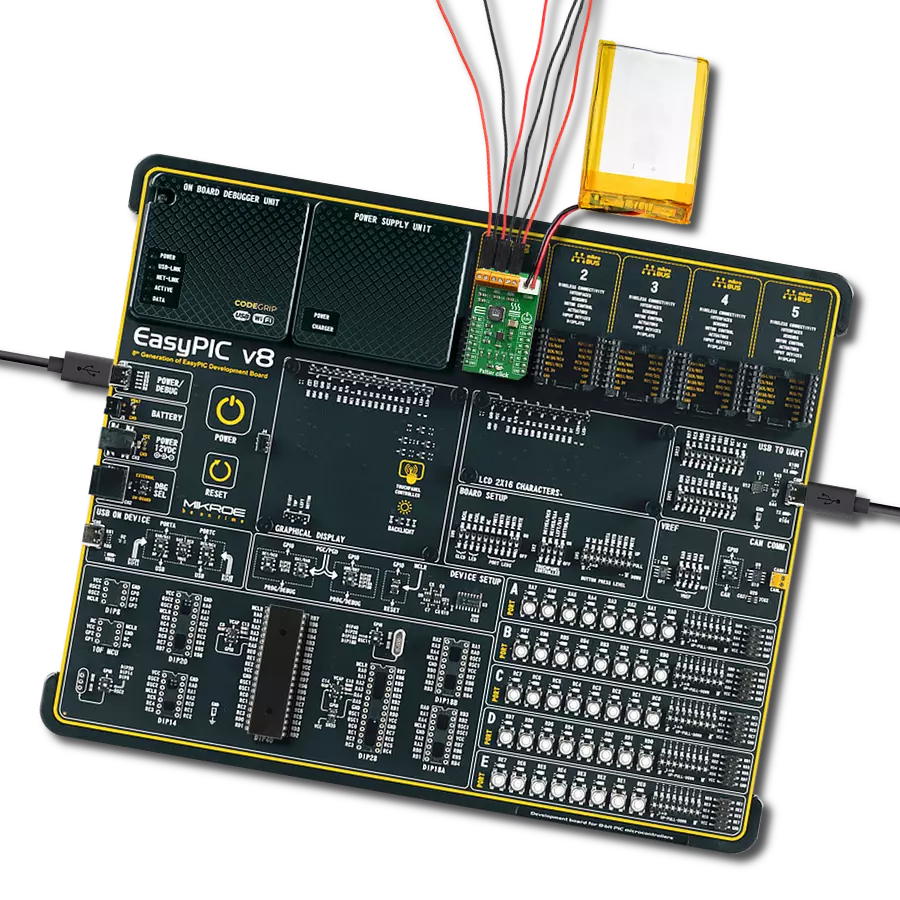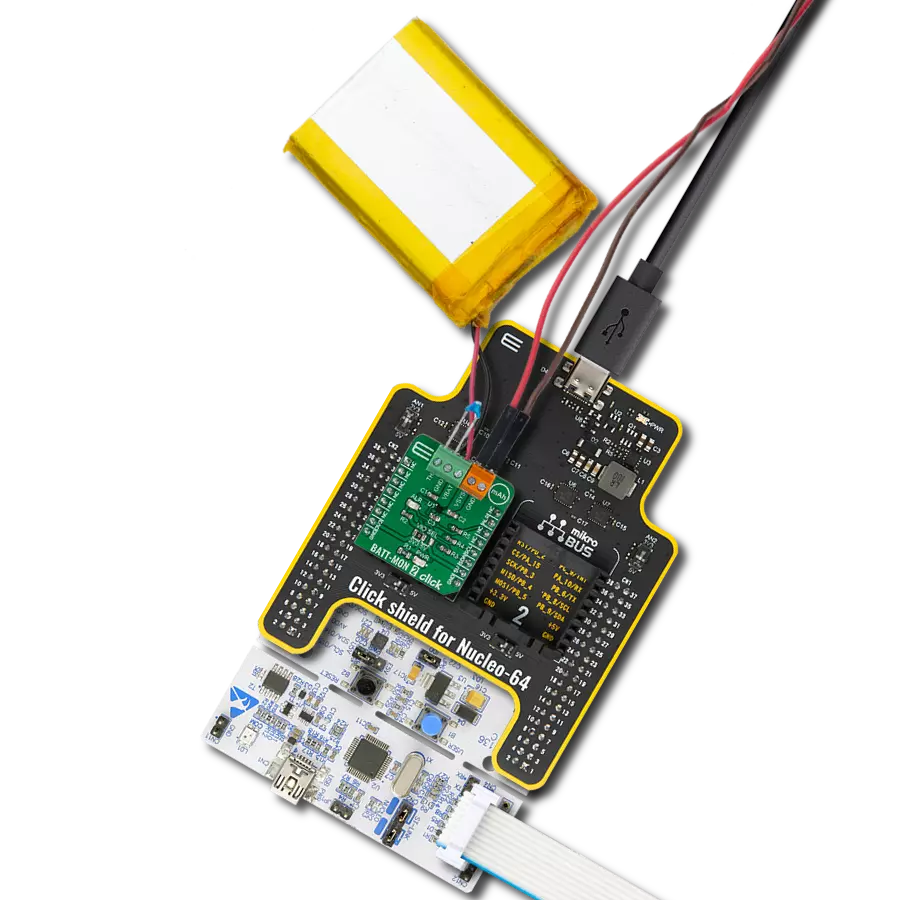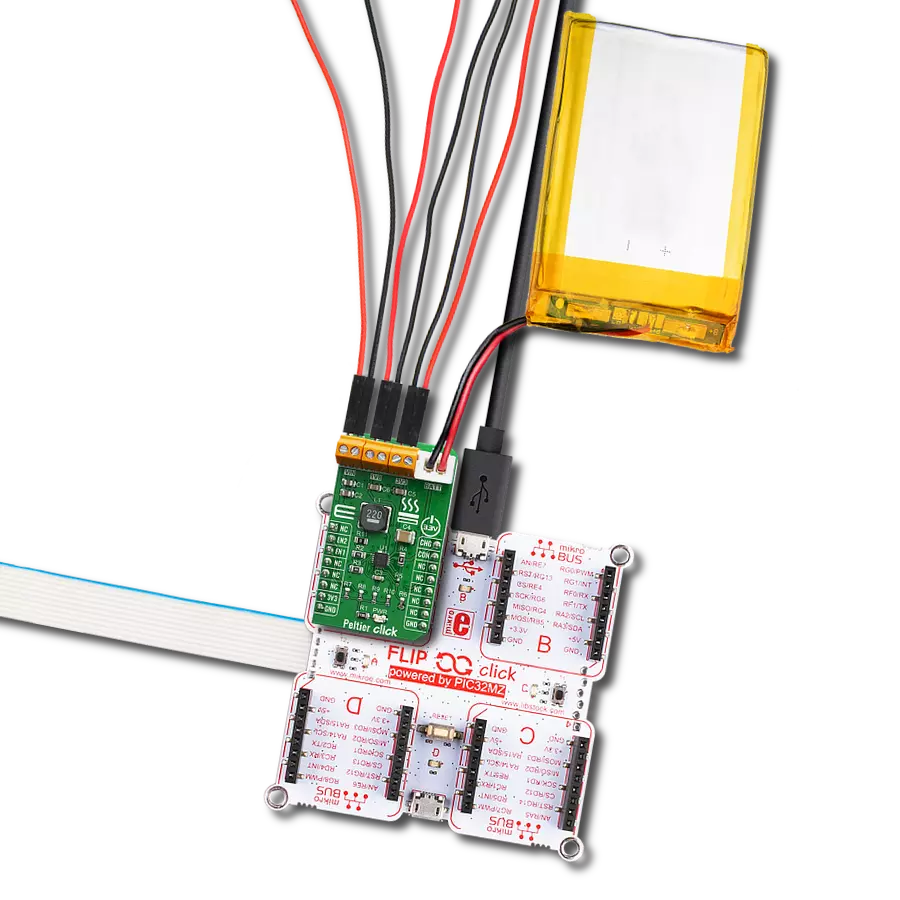Charging has never been so simple, yet so powerful, as we bring a new level of efficiency to the world of portable energy.
A
A
Hardware Overview
How does it work?
Charger 17 Click is based on the RT9471, a 3A single-cell switching battery charger from Richtek. The RT9471 supports USB OTG current and voltage limit regulations. In addition, the charger supports several protection features, such as over-temperature, VBUS over-voltage, battery over-voltage, system over-voltage, system under-voltage, and more. The Charger 17 Click for power input uses a USB C connector and 5V, where, in addition, you can use a VBUS/GND header for powering it from another external source as the VBUS RT4971 input has an operating range from 3.9 up to 13.5V. Charger 17 Click uses a properly labeled JST connector for connecting a battery, and one should take note of the battery polarity as the JST battery connector is NOT standardized. In addition to the battery connector, there is an SYS/GND header as a converter output connection point. The device provides automatic power path selection to the supply system from the USB C connector, the connected battery, or both of them over the VSYS/GND header. There is a shipping mode that allows you to turn the battery off when
shipping or in storage, thus extending the battery life. During charge status, the charger monitors the battery's voltage and selects the appropriate mode (battery supply mode to charge battery mode). In USB OtG applications, the RT9471 can achieve up to 92% boost efficiency at 1A with a 3.8V battery and a 5.15V output voltage. The RT9471 charger indicates how good the power source is over the power good PG LED indicator. This status includes applied VBUS when not in Sleep mode, charger thermal values under threshold settings when not in HZ mode, and more. The charging status can be visually monitored over the STAT LED indicator. The RT9471 supports JEITA protection during charge mode. The charger can measure the battery's temperature over the TEMP/GND header and the additional NTC thermistor. This feature can be selected from the TEMP REF solder jumper, which is set to the internal position by default. In both ways, the temperature window is programmed over the resistor divider. The device will stop charging the battery if the battery's temperature is lower
than T1 or higher than T4 values. For more information, please check the attached datasheet. Charger 17 Click uses a standard 2-Wire I2C interface to communicate with the host MCU, with speeds up to 3.4Mbits. There are some other functionalities for this Click board™, such as charge enable CE pin where you can turn off battery charging when driving this pin LOW. You can also control the BATFET over the QON pin. That includes exiting the shipping mode and system reset. You can select a power source current limit between 0.5A and 2.4A over the PSL pin. The charger can alert poor source detection, VBUS source type detection, and other events over the INT interrupt pin. This Click board™ can be operated only with a 3.3V logic voltage level. The board must perform appropriate logic voltage level conversion before using MCUs with different logic levels. Also, it comes equipped with a library containing functions and an example code that can be used as a reference for further development.
Features overview
Development board
Nucleo-64 with STM32F091RC MCU offers a cost-effective and adaptable platform for developers to explore new ideas and prototype their designs. This board harnesses the versatility of the STM32 microcontroller, enabling users to select the optimal balance of performance and power consumption for their projects. It accommodates the STM32 microcontroller in the LQFP64 package and includes essential components such as a user LED, which doubles as an ARDUINO® signal, alongside user and reset push-buttons, and a 32.768kHz crystal oscillator for precise timing operations. Designed with expansion and flexibility in mind, the Nucleo-64 board features an ARDUINO® Uno V3 expansion connector and ST morpho extension pin
headers, granting complete access to the STM32's I/Os for comprehensive project integration. Power supply options are adaptable, supporting ST-LINK USB VBUS or external power sources, ensuring adaptability in various development environments. The board also has an on-board ST-LINK debugger/programmer with USB re-enumeration capability, simplifying the programming and debugging process. Moreover, the board is designed to simplify advanced development with its external SMPS for efficient Vcore logic supply, support for USB Device full speed or USB SNK/UFP full speed, and built-in cryptographic features, enhancing both the power efficiency and security of projects. Additional connectivity is
provided through dedicated connectors for external SMPS experimentation, a USB connector for the ST-LINK, and a MIPI® debug connector, expanding the possibilities for hardware interfacing and experimentation. Developers will find extensive support through comprehensive free software libraries and examples, courtesy of the STM32Cube MCU Package. This, combined with compatibility with a wide array of Integrated Development Environments (IDEs), including IAR Embedded Workbench®, MDK-ARM, and STM32CubeIDE, ensures a smooth and efficient development experience, allowing users to fully leverage the capabilities of the Nucleo-64 board in their projects.
Microcontroller Overview
MCU Card / MCU
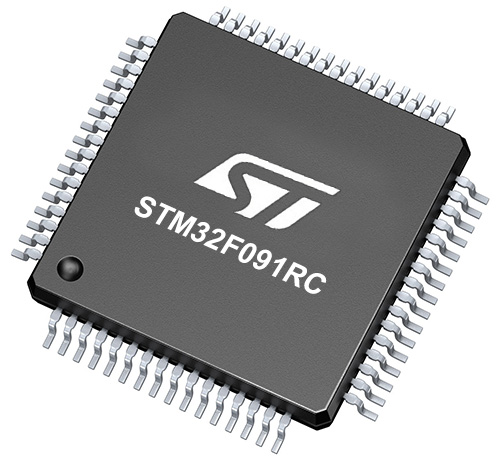
Architecture
ARM Cortex-M0
MCU Memory (KB)
256
Silicon Vendor
STMicroelectronics
Pin count
64
RAM (Bytes)
32768
You complete me!
Accessories
Click Shield for Nucleo-64 comes equipped with two proprietary mikroBUS™ sockets, allowing all the Click board™ devices to be interfaced with the STM32 Nucleo-64 board with no effort. This way, Mikroe allows its users to add any functionality from our ever-growing range of Click boards™, such as WiFi, GSM, GPS, Bluetooth, ZigBee, environmental sensors, LEDs, speech recognition, motor control, movement sensors, and many more. More than 1537 Click boards™, which can be stacked and integrated, are at your disposal. The STM32 Nucleo-64 boards are based on the microcontrollers in 64-pin packages, a 32-bit MCU with an ARM Cortex M4 processor operating at 84MHz, 512Kb Flash, and 96KB SRAM, divided into two regions where the top section represents the ST-Link/V2 debugger and programmer while the bottom section of the board is an actual development board. These boards are controlled and powered conveniently through a USB connection to program and efficiently debug the Nucleo-64 board out of the box, with an additional USB cable connected to the USB mini port on the board. Most of the STM32 microcontroller pins are brought to the IO pins on the left and right edge of the board, which are then connected to two existing mikroBUS™ sockets. This Click Shield also has several switches that perform functions such as selecting the logic levels of analog signals on mikroBUS™ sockets and selecting logic voltage levels of the mikroBUS™ sockets themselves. Besides, the user is offered the possibility of using any Click board™ with the help of existing bidirectional level-shifting voltage translators, regardless of whether the Click board™ operates at a 3.3V or 5V logic voltage level. Once you connect the STM32 Nucleo-64 board with our Click Shield for Nucleo-64, you can access hundreds of Click boards™, working with 3.3V or 5V logic voltage levels.
Li-Polymer Battery is the ideal solution for devices that demand a dependable and long-lasting power supply while emphasizing mobility. Its compatibility with mikromedia boards ensures easy integration without additional modifications. With a voltage output of 3.7V, the battery meets the standard requirements of many electronic devices. Additionally, boasting a capacity of 2000mAh, it can store a substantial amount of energy, providing sustained power for extended periods. This feature minimizes the need for frequent recharging or replacement. Overall, the Li-Polymer Battery is a reliable and autonomous power source, ideally suited for devices requiring a stable and enduring energy solution. You can find a more extensive choice of Li-Polymer batteries in our offer.
Used MCU Pins
mikroBUS™ mapper
Take a closer look
Click board™ Schematic

Step by step
Project assembly
Track your results in real time
Application Output
1. Application Output - In Debug mode, the 'Application Output' window enables real-time data monitoring, offering direct insight into execution results. Ensure proper data display by configuring the environment correctly using the provided tutorial.

2. UART Terminal - Use the UART Terminal to monitor data transmission via a USB to UART converter, allowing direct communication between the Click board™ and your development system. Configure the baud rate and other serial settings according to your project's requirements to ensure proper functionality. For step-by-step setup instructions, refer to the provided tutorial.

3. Plot Output - The Plot feature offers a powerful way to visualize real-time sensor data, enabling trend analysis, debugging, and comparison of multiple data points. To set it up correctly, follow the provided tutorial, which includes a step-by-step example of using the Plot feature to display Click board™ readings. To use the Plot feature in your code, use the function: plot(*insert_graph_name*, variable_name);. This is a general format, and it is up to the user to replace 'insert_graph_name' with the actual graph name and 'variable_name' with the parameter to be displayed.

Software Support
Library Description
This library contains API for Charger 17 Click driver.
Key functions:
charger17_enable_charging- This function enables charging by setting the CE pin to low logic state.charger17_set_psel_2400mA- This function sets charging current to 2400mA by setting the PSEL pin to low logic state.charger17_read_register- This function reads data from the selected register by using I2C serial interface.
Open Source
Code example
The complete application code and a ready-to-use project are available through the NECTO Studio Package Manager for direct installation in the NECTO Studio. The application code can also be found on the MIKROE GitHub account.
/*!
* @file main.c
* @brief Charger 17 Click example
*
* # Description
* This example demonstrates the use of Charger 17 Click board by enabling battery charging and
* displaying the charging status.
*
* The demo application is composed of two sections :
*
* ## Application Init
* Initializes the driver and performs the Click default configuration which enables charging.
*
* ## Application Task
* Reads and displays the battery charging status (IC_STATUS and STAT0 regs) on the USB UART
* approximately once per second.
*
* @author Stefan Filipovic
*
*/
#include "board.h"
#include "log.h"
#include "charger17.h"
static charger17_t charger17;
static log_t logger;
/**
* @brief Charger 17 parse ic status function.
* @details This function parses and displays on the USB UART the IC_STATUS register value from input.
* @param[in] ic_status : IC status register data.
* @return None.
* @note None.
*/
static void charger17_parse_ic_status ( uint8_t ic_status );
/**
* @brief Charger 17 parse status 0 function.
* @details This function parses and displays on the USB UART the STAT0 register value from input.
* @param[in] status_0 : STAT0 register data.
* @return None.
* @note None.
*/
static void charger17_parse_status_0 ( uint8_t status_0 );
void application_init ( void )
{
log_cfg_t log_cfg; /**< Logger config object. */
charger17_cfg_t charger17_cfg; /**< Click config object. */
/**
* Logger initialization.
* Default baud rate: 115200
* Default log level: LOG_LEVEL_DEBUG
* @note If USB_UART_RX and USB_UART_TX
* are defined as HAL_PIN_NC, you will
* need to define them manually for log to work.
* See @b LOG_MAP_USB_UART macro definition for detailed explanation.
*/
LOG_MAP_USB_UART( log_cfg );
log_init( &logger, &log_cfg );
log_info( &logger, " Application Init " );
// Click initialization.
charger17_cfg_setup( &charger17_cfg );
CHARGER17_MAP_MIKROBUS( charger17_cfg, MIKROBUS_1 );
if ( I2C_MASTER_ERROR == charger17_init( &charger17, &charger17_cfg ) )
{
log_error( &logger, " Communication init." );
for ( ; ; );
}
if ( CHARGER17_ERROR == charger17_default_cfg ( &charger17 ) )
{
log_error( &logger, " Default configuration." );
for ( ; ; );
}
log_info( &logger, " Application Task " );
}
void application_task ( void )
{
uint8_t ic_status, status_0;
if ( CHARGER17_OK == charger17_read_register ( &charger17, CHARGER17_REG_IC_STATUS, &ic_status ) )
{
charger17_parse_ic_status ( ic_status );
}
if ( CHARGER17_OK == charger17_read_register ( &charger17, CHARGER17_REG_STAT0, &status_0 ) )
{
charger17_parse_status_0 ( status_0 );
}
Delay_ms ( 1000 );
}
int main ( void )
{
/* Do not remove this line or clock might not be set correctly. */
#ifdef PREINIT_SUPPORTED
preinit();
#endif
application_init( );
for ( ; ; )
{
application_task( );
}
return 0;
}
static void charger17_parse_ic_status ( uint8_t ic_status )
{
log_printf ( &logger, "\r\n IC status\r\n" );
log_printf ( &logger, " PORT: " );
switch ( ic_status & CHARGER17_PORT_STAT_BIT_MASK )
{
case CHARGER17_PORT_STAT_VBUS_DEV_1:
{
log_printf ( &logger, "VBUS = device 1 (2100mA-APPLE-10w)\r\n" );
break;
}
case CHARGER17_PORT_STAT_VBUS_DEV_2:
{
log_printf ( &logger, "VBUS = device 2 (2000mA-SAMSUNG-10w)\r\n" );
break;
}
case CHARGER17_PORT_STAT_VBUS_DEV_3:
{
log_printf ( &logger, "VBUS = device 3 (1000mA-APPLE-5w)\r\n" );
break;
}
case CHARGER17_PORT_STAT_VBUS_DEV_4:
{
log_printf ( &logger, "VBUS = device 4 (2400mA-APPLE-12w)\r\n" );
break;
}
case CHARGER17_PORT_STAT_VBUS_UNKNOWN:
{
log_printf ( &logger, "VBUS = unknown / NSDP (500mA)\r\n" );
break;
}
case CHARGER17_PORT_STAT_VBUS_SDP:
{
log_printf ( &logger, "VBUS = SDP (500mA) / PSEL = High\r\n" );
break;
}
case CHARGER17_PORT_STAT_VBUS_CDP:
{
log_printf ( &logger, "VBUS = CDP (1500mA)\r\n" );
break;
}
case CHARGER17_PORT_STAT_VBUS_DCP:
{
log_printf ( &logger, "VBUS = DCP (2400mA) / PSEL = Low\r\n" );
break;
}
default:
{
log_printf ( &logger, "No information\r\n" );
break;
}
}
log_printf ( &logger, " IC: " );
switch ( ic_status & CHARGER17_IC_STAT_BIT_MASK )
{
case CHARGER17_IC_STAT_HZ_SLEEP:
{
log_printf ( &logger, "HZ/SLEEP\r\n" );
break;
}
case CHARGER17_IC_STAT_VBUS_READY:
{
log_printf ( &logger, "VBUS ready for charge\r\n" );
break;
}
case CHARGER17_IC_STAT_TRICKLE_CHG:
{
log_printf ( &logger, "Trickle-charge\r\n" );
break;
}
case CHARGER17_IC_STAT_PRE_CHG:
{
log_printf ( &logger, "Pre-charge\r\n" );
break;
}
case CHARGER17_IC_STAT_FAST_CHG:
{
log_printf ( &logger, "Fast-charge\r\n" );
break;
}
case CHARGER17_IC_STAT_IEOC_CHG:
{
log_printf ( &logger, "IEOC-charge (EOC and TE = 0)\r\n" );
break;
}
case CHARGER17_IC_STAT_BACK_GROUND_CHG:
{
log_printf ( &logger, "Back-Ground charge (EOC and TE = 1 and before turn off power path)\r\n" );
break;
}
case CHARGER17_IC_STAT_CHG_DONE:
{
log_printf ( &logger, "Charge done (EOC and TE = 1 and power path off)\r\n" );
break;
}
case CHARGER17_IC_STAT_CHG_FAULT:
{
log_printf ( &logger, "Charge fault (VAC_OV/CHG_BUSUV/CHG_TOUT/CHG_SYSOV/CHG_BATOV/JEITA_HOT/JEITA_COLD/OTP)\r\n" );
break;
}
case CHARGER17_IC_STAT_OTG:
{
log_printf ( &logger, "OTG\r\n" );
break;
}
default:
{
log_printf ( &logger, "No information\r\n" );
break;
}
}
}
static void charger17_parse_status_0 ( uint8_t status_0 )
{
log_printf ( &logger, "\r\n Status 0\r\n" );
log_printf ( &logger, " VBUS_GD: VBUS %s good\r\n",
( char * ) ( ( status_0 & CHARGER17_STAT0_VBUS_GD ) ? "is" : "is not" ) );
log_printf ( &logger, " CHG_RDY: VBUS %s ready for charging\r\n",
( char * ) ( ( status_0 & CHARGER17_STAT0_CHG_RDY ) ? "is" : "is not" ) );
log_printf ( &logger, " IEOC: %s in EOC\r\n",
( char * ) ( ( status_0 & CHARGER17_STAT0_IEOC ) ? "While" : "Not in" ) );
log_printf ( &logger, " BG_CHG: %s\r\n",
( char * ) ( ( status_0 & CHARGER17_STAT0_BG_CHG ) ? "While in EOC state and TE = 1 and BG_CHG_TMR != 00" :
"Not in EOC state or TE = 0 or BG_CHG_TMR = 00" ) );
log_printf ( &logger, " CHG_DONE: %s\r\n",
( char * ) ( ( status_0 & CHARGER17_STAT0_CHG_DONE ) ? "While in EOC state and BATFET off" :
"Not in EOC state or BATFET on" ) );
log_printf ( &logger, " BC12_DONE: BC1.2 process %s\r\n",
( char * ) ( ( status_0 & CHARGER17_STAT0_BC12_DONE ) ? "done" : "not ready" ) );
}
// ------------------------------------------------------------------------ END
Additional Support
Resources
Category:Battery charger
